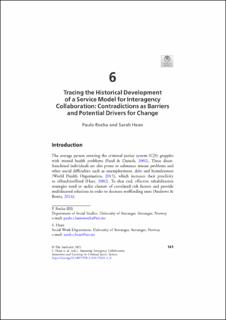| dc.contributor.author | Bastos Rocha, Paulo Thiago | |
| dc.contributor.author | Hean, Sarah Catherine Patricia Duff | |
| dc.date.accessioned | 2023-03-09T10:16:47Z | |
| dc.date.available | 2023-03-09T10:16:47Z | |
| dc.date.created | 2021-03-09T12:00:34Z | |
| dc.date.issued | 2021 | |
| dc.identifier.citation | Rocha, P., & Hean, S. (2021). Tracing the historical development of a service model for interagency collaboration: contradictions as barriers and potential drivers for change. In Improving Interagency Collaboration, Innovation and Learning in Criminal Justice Systems: Supporting Offender Rehabilitation (pp. 141-164). Cham: Springer International Publishing. | en_US |
| dc.identifier.isbn | 9783030706616 | |
| dc.identifier.uri | https://hdl.handle.net/11250/3057283 | |
| dc.description.abstract | In England and Wales, Liaison and Diversion (L&D) services work to facilitate integrated rehabilitative interventions orchestrated between Criminal Justice and Welfare systems to improve health and social care outcomes. A new L&D national model was introduced in 2014 to unify practice across all L&D sites. This chapter analyses the L&D’s historical activity before, during and after the process of implementation of this national model and provides a timeline whereby potential tensions and their underlying contradictions within and between the L&D and neighbouring services activity systems are identified. A case study of an L&D service in southern England is used by way of illustration and Cultural-Historical Activity Theory (CHAT) articulates the complexity of interactions between the professionals at the street-level. Our findings showed that fragmented information technology (IT) systems, both intra- and interagency, have been particularly problematic in this setting and that the national model was not apt to transform this situation. Fragmentation hinders information sharing and ultimately affects professionals’ capacity to collaborate. We suggest service providers at a local level engage in a dialogue with one another and that they are in a better position to govern local practices instead of having policy enforced unilaterally top-down. | en_US |
| dc.language.iso | eng | en_US |
| dc.publisher | Springer | en_US |
| dc.relation.ispartof | Improving interagency collaboration innovation and learning in criminal justice systems : Supporting offender rehabilitation | |
| dc.rights | Navngivelse 4.0 Internasjonal | * |
| dc.rights.uri | http://creativecommons.org/licenses/by/4.0/deed.no | * |
| dc.title | Tracing the historical development of a service model for interagency collaboration : Contradictions as barriers and potential drivers for change | en_US |
| dc.type | Chapter | en_US |
| dc.description.version | publishedVersion | en_US |
| dc.rights.holder | The authors | en_US |
| dc.subject.nsi | VDP::Samfunnsvitenskap: 200::Kriminologi: 350 | en_US |
| dc.source.pagenumber | 141-164 | en_US |
| dc.identifier.doi | 10.1007/978-3-030-70661-6_6 | |
| dc.identifier.cristin | 1896616 | |
| cristin.ispublished | true | |
| cristin.fulltext | original | |
| cristin.qualitycode | 2 | |

